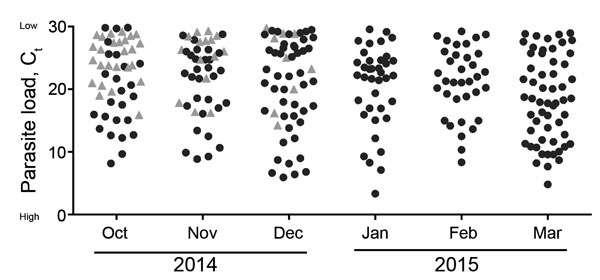The Merits of Malaria Diagnostics during an Ebola Virus Disease Outbreak
Emmie de Wit, Darryl Falzarano
1, Clayton Onyango, Kyle Rosenke, Andrea Marzi, Melvin Ochieng, Bonventure Juma, Robert J. Fischer, Joseph B. Prescott, David Safronetz
2, Victor Omballa, Collins Owuor, Thomas Hoenen
3, Allison Groseth
3, Neeltje van Doremalen, Galina Zemtsova, Joshua Self, Trenton Bushmaker, Kristin McNally, Thomas Rowe, Shannon L. Emery, Friederike Feldmann, Brandi Williamson, Tolbert G. Nyenswah, Allen Grolla, James E. Strong, Gary Kobinger, Ute Stroeher, Mark Rayfield, Fatorma K. Bolay, Kathryn C. Zoon, Jorgen Stassijns, Livia Tampellini, Martin de Smet, Stuart T. Nichol, Barry Fields, Armand Sprecher, Heinz Feldmann, Moses Massaquoi, and Vincent J. Munster

Author affiliations: National Institutes of Health, Hamilton, Montana, USA (E. de Wit, D. Falzarano, K. Rosenke, A. Marzi, R.J. Fischer, J.B. Prescott, D. Safronetz, T. Hoenen, A. Groseth, N. van Doremalen, T. Bushmaker, K. McNally, F. Feldmann, B. Williamson, H. Feldmann, V.J. Munster); Centers for Disease Control and Prevention, Nairobi, Kenya (C. Onyango, B. Juma, B. Fields); Kenya Medical Research Institute, Nairobi (M. Ochieng, V. Omballa, C. Owuor); Centers for Disease Control and Prevention, Atlanta, Georgia, USA (G. Zemtsova, J. Self, T. Rowe, S.L. Emery, U. Stroeher, M. Rayfield, S.T. Nichol); Ministry of Health and Social Welfare, Monrovia, Liberia (T.G. Nyenswah, M. Massaquoi); Public Health Agency of Canada, Winnipeg, Manitoba, Canada (A. Grolla, J.E. Strong, G. Kobinger); Liberian Institute for Biomedical Research, Charlesville, Liberia (F.K. Bolay); National Institutes of Health, Bethesda, Maryland, USA (K.C. Zoon); Médecins Sans Frontières, Brussels, Belgium (J. Stassijns, L. Tampellini, M. de Smet, A. Sprecher)
Main Article
Figure 2

Figure 2. Inverse parasite load in patients with Plasmodium spp. parasitemia over time by month of sample submission, for samples submitted to the Centers for Disease Control and Prevention–National Institutes of Health diagnostic laboratory at the Eternal Love Winning Africa campus in Monrovia, Liberia, from October 12, 2014, through March 28, 2015. Cycle threshold (Ct) values were detected by using real-time quantitative reverse transcription PCR. Triangles represent parasite loads in parasitemic patients co-infected with Ebola virus; circles represent patients with Plasmodium spp. parasitemia only. In West Africa, similar to other malaria-endemic regions, a large proportion of the population is infected with Plasmodium parasites without developing clinical disease. To compensate for this and the higher sensitivity of the PCR assay compared with light microscopy, we used a cutoff of Ct <30 rather than Ct <40 under the assumption that a 10-Ct difference would compensate for the ≈1,000-fold higher sensitivity of PCR over microscopy. This principle could be carried further to assume that a Ct <25 would be in the range detectable by the rapid diagnostic test. Of note, high Ct values correspond to low parasitemia levels and vice versa.
Main Article
Page created: January 15, 2016
Page updated: January 15, 2016
Page reviewed: January 15, 2016
The conclusions, findings, and opinions expressed by authors contributing to this journal do not necessarily reflect the official position of the U.S. Department of Health and Human Services, the Public Health Service, the Centers for Disease Control and Prevention, or the authors' affiliated institutions. Use of trade names is for identification only and does not imply endorsement by any of the groups named above.
